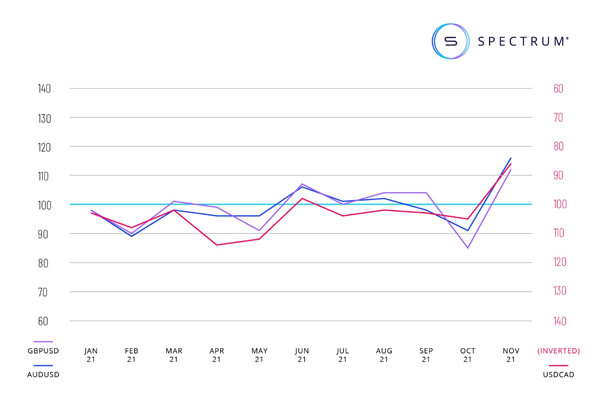- Retail investors bullish on AUD, CAD and GBP against USD
- Diverging central bank policy looks to be key sentiment driver for currency pairs
- Record 106.3 million securitised derivatives were traded on Spectrum Markets last month
Spectrum Markets, the pan-European trading venue for securitised derivatives, has published its SERIX European retail investor sentiment data for November (see below for more information on methodology), which indicates a bullish view towards currencies where central banks are tightening monetary policy, compared to the US dollar.
Retail investors trading instruments linked to currency pairs on the exchange in November indicated a positive outlook for the Canadian and Australian dollars, as well as the British pound, against the US dollar.
The Bank of Canada indicated at the end of October that interest rates could rise in the second half of 2022, while the Reserve Bank of Australia sent its strongest signal yet that the emergency measures it introduced to support the economy during the Covid pandemic will now be wound back, paving the way for an earlier than expected interest rate rise.
Australia’s central bank left the official cash rate target at the record low 0.1% annual rate set at the November board meeting last year, though analyst attention focused on the shift in the language of its accompanying commentary which suggested a tightening of monetary policy could be on the horizon.
However, like many others in the market, retail investors were caught out by the Bank of England’s unexpected decision not to announce an interest rate rise in November. Bullish trading in instruments linked to GBP/USD peaked on November 4th, ahead of the Bank’s highly anticipated Monetary Policy Committee meeting, but sentiment dropped when no new policy measures were announced.
For much of last month the Federal Reserve stood out from many central banks by maintaining a looser monetary policy than several of its peers, leading investors to favour other currencies over the US dollar in the short term.
The SERIX chart on USD-linked currency pairs for November clearly reflects this movement, which shows sentiment towards the US dollar lagging when compared to the Australian and Canadian dollars and the British pound.
“After a long low-interest period it seems that most central banks are looking to flip the switch in order to control growing inflation fears. Retail investors have been looking for first mover advantage benefits throughout November and seem to have found this in the currencies of Canada and Australia, though many will have been left disappointed by a lack of action from the United Kingdom,” explains Michael Hall, Head of Distribution of Spectrum Markets.
“The signals we are getting from central banks, and the actions they are taking, are currently being discussed in the market in quite contrasting ways with some, but not all, deciding to withdraw at least part of their stimulus measures. The Fed’s hesitation in particular has given retail investors some interesting investment opportunities”, adds Hall.
During November, a record 106.3 million securitised derivatives were traded on Spectrum, with 35.9% of trades taking place outside of traditional hours (i.e. between 17:30 and 9:00 CET). 81.5% of the traded derivatives were on indices, 9.7% on currency pairs, 7.1% on commodities, and 1.7% on equities, with the top three traded underlying markets being NASDAQ 100 (24.4%), DAX 40 (19.9%), and S&P 500 (10.8%).
Looking at the SERIX data for the top three underlying markets, the NASDAQ 100 and DAX 40 were relatively unchanged at 98 and 99 respectively. Meanwhile the S&P 500 rose slightly, from 93 to 97, while remaining in the bearish zone overall.

Calculating SERIX data
The Spectrum European Retail Investor Index (SERIX), uses the exchange’s pan-European trading data to shed light on investor sentiment towards current development in financial markets.
The index is calculated on a monthly basis by analysing retail investor trades placed and subtracting the proportion of bearish trades from the proportion of bullish trades, to give a single figure (rebased at 100) that indicates the strength and direction of sentiment:
SERIX = (% bullish trades - % bearish trades) + 100
Trades where long instruments are bought and trades where short instruments are sold are both considered bullish trades, while trades where long instruments are sold and trades where short instruments are bought are considered bearish trades. Trades that are matched by retail clients are disregarded. (For a detailed methodology and examples, please visit this link).




